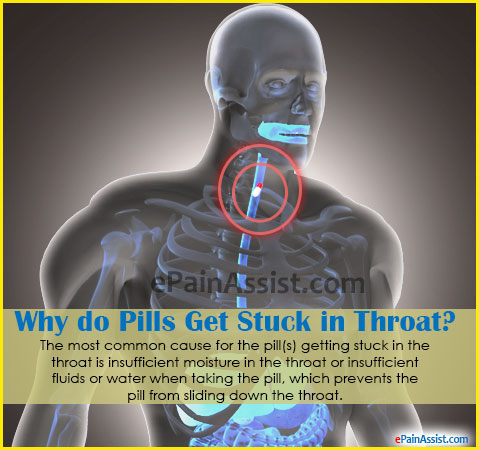Why do Pills Get Stuck in Throat?
All of us have experienced that terrifying moment in our lives when a pill gets stuck in our throat. It can be quite a panicky feeling; however, stay calm because a pill getting stuck in the throat is rarely a medical emergency. Whenever we swallow a pill, whether it is over-the-counter medication or a prescription medication, sometimes, it can feel as if it is stuck in our throat. We should remember that our throat is sufficient in size to accommodate most of the pills which we take; however, sometimes a pill can get lodged in our throat behind voice box (larynx), which can be a very uncomfortable feeling. We can ensure that we swallow our pills easily every time by swallowing the pill with adequate amount of water in the right manner and preparing our mouth properly.

The most common cause for the pill(s) getting stuck in the throat is insufficient moisture in the throat or insufficient fluids or water when taking the pill, which prevents the pill from sliding down the throat. Any pills, including gel caps and coated ones are quite difficult to swallow without any fluid. Pills often get stuck in throat just about the location of the crico-pharyngeus muscle or the sphincter, which is present at the top of the esophagus. Individuals with disorders of this muscle may suffer with weakness or hypertrophy of muscles resulting in difficulties in swallowing pills. Other than this, age may interfere with reflexes of swallowing in young children and elderly people resulting in difficulties of swallowing pills.
There are some medicines may be difficult to swallow. Medications which are prescribed for osteoporosis may cause throat irritation and swallowing difficulties. Individuals who are taking these pills are instructed to sit straight or upright during and after the swallowing of pills for at least half-an-hour after taking the medicine. This is to prevent frequent osteoporosis pills getting stuck in throat causing esophagitis, which is inflammation of the esophagus. Anti-inflammatory medicines, such as ibuprofen and other medicines, such as iron, tetracycline antibiotics and potassium can also cause irritation to the esophagus.

What to do for Pills Getting Stuck in the Throat
Prevention is the key to avoid the problem of pill(s) getting stuck in the throat. The following steps should be undertaken to avoid this problem:
- Before placing the pill in your mouth, make sure to take a sip of water, as this will help in wetting the throat and prepares it for the pill. You can try taking another sip and hold the water in your mouth. Next, take the pill in your mouth and the water which is already present in the mouth helps in making the pill slicker and allows it to slide easily down your throat.
- Keep your chin tucked in towards your chest and swallow the pill. This will give the throat muscles some room so that the pill can become unstuck. Commonly, what we do is tilt our head back when swallowing, but tucking our head down actually forces the pill to the back of the throat so it can pass easily down. Swallow hard so that the liquid in your mouth passes along with the pill.
- Always take your pill with plenty of fluids. It is important to drink sufficient amount of fluids with the pill so that the pill passes easily down the throat.
- Never ever take any medicine when lying down. Always sit or stand straight when swallowing a pill. Try to sit upright for at least half an hour after swallowing the pill.
- Despite following the above steps, if the pill still gets stuck in your throat, then eat a piece of food which is easy to swallow, such as bread so that it will help push the pill downwards. However, make sure that the food, which you are taking, is compatible with your medication by reading the information on the labels of your medication.
- If the sensation of pill being stuck in the throat still persists, then swallow some thick drink in order to help push the pill down. The liquid should be thicker than water, such as a milkshake or fruit juice. This will also help in getting rid of the unpleasant sensation which stays after swallowing the pill.
- If you frequently have the problem of the pill getting stuck in your throat, even with food or thick liquids, then you should talk to your doctor about it and see if he/she can prescribe a liquid version of the medication, so it is easier for you to take your medicine in a correct and effective manner. Also, you can ask your doctor if the pills can be mixed with food or crushed up or dissolved in water to avoid getting them stuck in the throat. Things which you should always keep handy when swallowing a pill include: water, juice/milk shake and bread.
- If the patient is able to cough, then it means that he/ she can breathe and their airway is not completely obstructed. The person should be encouraged to continue to cough, so that the pill comes out.
- A stuck pill should not be left in the throat thinking that it will dissolve there, as a pill may burn the lining of the throat, leading to esophagitis, which is a condition where there is inflammation of the esophagus. This can further make the swallowing painful and difficult.
- If the feeling of the pill stuck in the throat still continues, then seek medical attention. Treatment can comprise of measures to decrease the inflammation, and medicines to reduce the acid production if reflux is thought to worsen the symptoms. An upper GI endoscopy is done in rare cases.
What to do if the Person Can’t Breathe?
Individual may not be able to breath and may be coughing non-stop if swallowed pill is stuck behind or within the voice box as well as breathing tube. If individual is complaining of difficulties in breathing, then you should try the Heimlich maneuver or the Five-and-Five method. Before starting on these maneuvers, have someone call 911.
How to Perform the Heimlich Method?
- Stand behind the choking person and wrap your arms around their mid abdomen close to belly button.
- Lean the patient forwards.
- Use your hand to make a fist and place firmly above the person’s navel.
- Press into the patient’s abdomen followed by an upward movement.
- Repeat this for 5 times.
- If the pill still continues to be stuck in the patient’s throat, then repeat this 5 more times.
- If the patient is unconscious and medical help is delayed, then it is important to clear their airway carefully using your finger. This should be done using index finger to feel and hook out the foreign body from throat carefully so as to avoid pushing the pill further down the throat.
- Pills stuck within breathing tube (trachea) cannot be removed by finger, instead make sure individual is breathing and exchanging air.
How to Perform the Red Cross’ Five-and-Five Method?
- Stand behind the choking person and lean their body forwards.
- Using the heel of your hand, give 5 blows to the patient’s back.
- Keep your thumb side of the fist above the patient’s navel, against their mid abdomen.
- Hold your wrist using your other hand.
- Give 5 quick shoves to the abdomen.
- Repeat this process till the patient coughs or till the pill comes out.
What to do if you are Alone & the Pill gets Stuck in your Throat
- Make a fist and place your thumb above the navel and below your rib cage.
- Make a fist of left hand. Hold the hand fist with your other hand and press it into your lower rib cage using a quick upward motion.
- Alternatively, you can also lean over a railing, chair or table edge and push your abdominal region against the edge.
- Other method to dislodge the pill from your throat is to put some water in your mouth, then lie down flat and swallow. The water will help flush down the pill to your esophagus and lying down helps in relaxing the throat so the pill can move behind the voice box in to esophagus.
Also Read:
